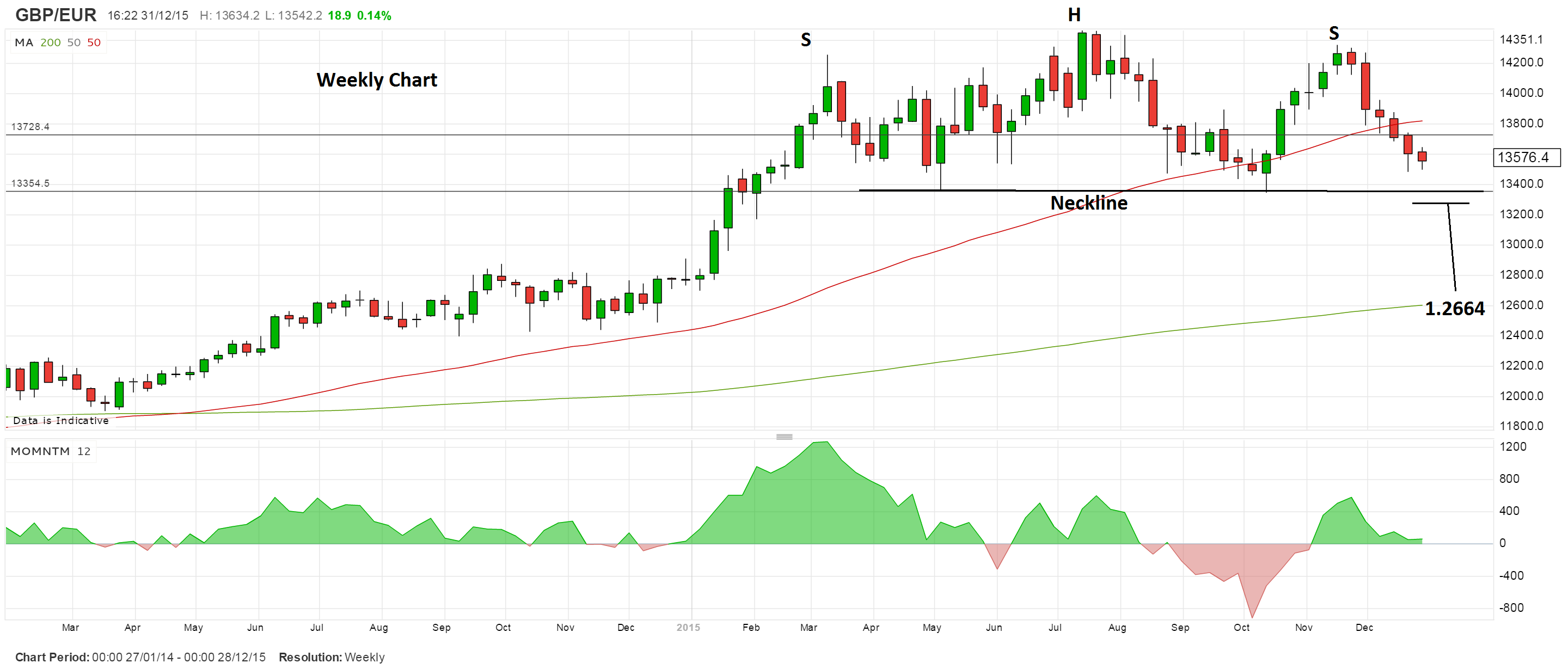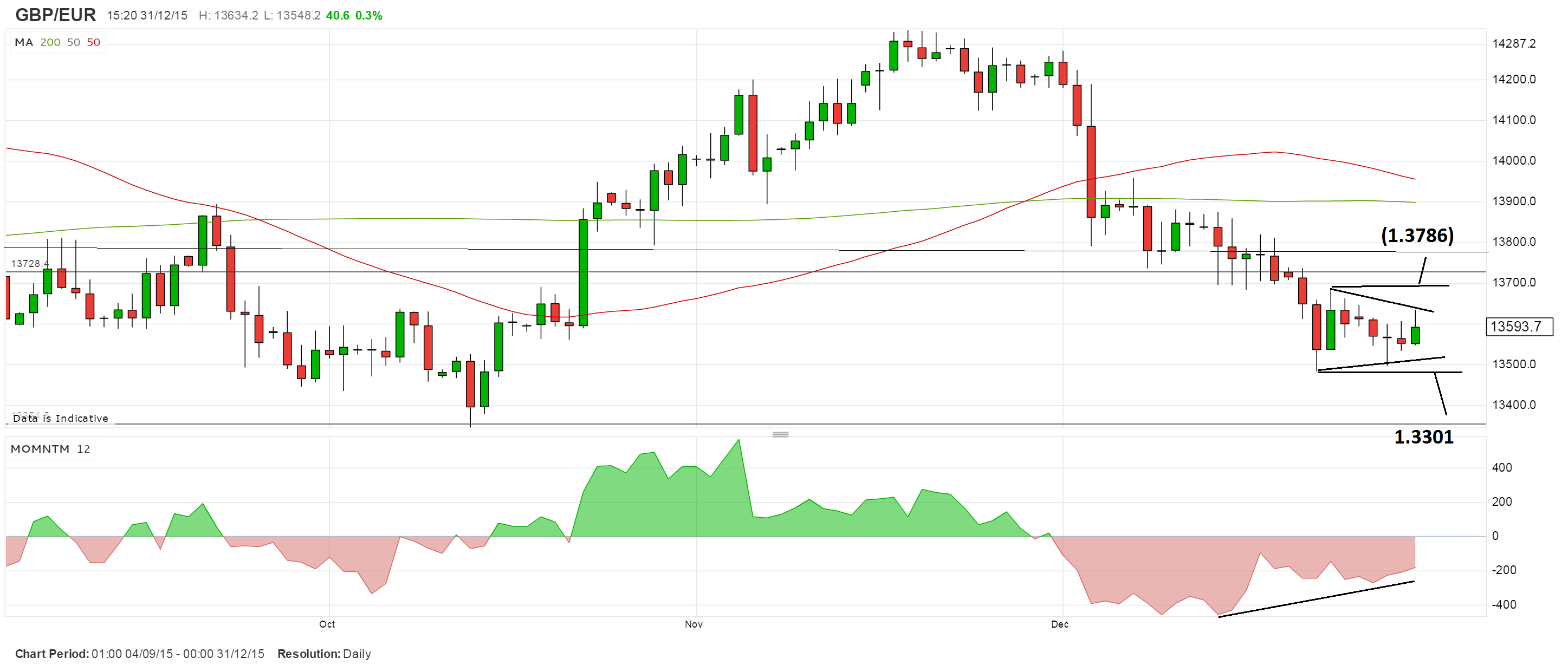GBP/EUR: Flat After Euro Loses its Lustre; 1.3346 Still Targeted
GBP/EUR has started moving sideways as sentiment towards the euro dampens, the long-term outlook remains bearish for the pair, however, as analysts prefer the euro going into 2016.

The pound has managed to steady itself over the last few days, despite ongoing pressure from Brexit fears, perhaps due to risks now being priced in.
The pair will probably eventually start moving lower again, however, as most analysts see the longer-term outlook for the euro as broadly better than for sterling.
From a technical perspective, the charts are showing the start of a possible triangle pattern, which is normally associated with a continuation of the trend prior to the formation of the pattern, which in this case is down.
This would also support the fundamental outlook for more euro strength versus sterling weakness.
QE expectations fading
Analysts remain broadly positive about the prospects for the single currency in the mid to long term, due to improving economic prospects, which have been borne out by recent stats showing rises in growth, inflation and employment.
However, it is also expected to benefit from a softening in ECB policy, with the central bank expected to take a less dovish line in the future, a view which is steadily gaining traction amongst market-watchers.
A recent survey of economists by the Financial Times saw a marked increase in the number who expected the ECB to do nothing in 2016, from an almost non-existent number in last year’s survey:
“just under half of the 33 respondents thought the ECB would do nothing this year,” said the FT.
“The rest said the ECB would expand QE or cut interest rates, although some of those who expected more easing stressed that the central bank was unlikely to radically reshape its existing policy response.”
Some, however, continue to see the recovery in the euro-zone as too sluggish to dismiss the possibility of more easing:
“The pressure for the ECB to provide more support is likely if, as we expect, the economic recovery remains sluggish and inflation low,” said Jonathan Loynes, chief European economist at Capital Economics.
The FT survey backs-up recent research from Italy’s Banca IMI, which suggested more ECB QE was unlikely given the lack of available supply of Bonds, particularly in Germany and Portugual.
“The market expectations that the ECB may decide in the first months of next year to step up monthly purchases of government bonds seem unrealistic by all accounts, given the serious constraint already imposed by the size of the German market.”
Banca IMI argue that the market underestimated the scope of the changes to QE made by the ECB at the December meeting,
“Despite the disappointment of the market, which had built up exaggeratedly high expectations, the decision taken at the latest ECB meeting, which extends the EAPP until at least March 2017, implies 280 billion euros in additional purchases of government bonds and agencies, marking a 35% increase over the old programme.”
Sterling outlook paling
A growing number of analysts are taking a negative view of the pound in the new year, mainly as a result of Brexit fears and BOE rate hike expectations being pushed back.
Given the results from a recent major poll of 20,000 respondents showed the ‘out’s’ winning by 47% to the ‘in’s’ 38% and 15% undecided Brexit could really become a major issue for sterling in coming months, particularly if the data for a referendum is brought forward from 2017 as many expect.
Analysts still remain divided on when the BOE could hike rates, however, with some still clinging to the possibility of a May hike, and others stalling to the end of the year or even into 2017.
A view from the Charts
The longer-term technical outlook for GBP/EUR contains increasingly bearish signs.
The month of December represents a particularly strong move lower, and a possible predictor of further weakness, however, first it would require a breakdown through the neckline of the consolidation pattern - possibly a bearish head and shoulders - at 1.3300, for confirmation of a break lower.
Such a move, however, would probably then see the pair break down all the way to 1.2664, near the 200-week MA.

The short-term chart below, shows a consolidation in a triangle formation in the midst of the recent short-term down-trend.
As mentioned before the triangle will probably break lower, but I would be looking for a move below the previous lows of the 22nd, at 1.3483, for confirmation, followed by a bearish continuation to the 1.3346 lows and the neckline of the large H&S pictured on the weekly chart.
Nevertheless, a bullish convergence with momentum and rising Chaikin Money Flow in the triangle warns of potential underlying strength within the pattern, which could possibly also lead to a surprise break higher, with a move above the 1.3684 highs, leading to a move up to the probable location of January’s monthly pivot at about 1.3786.





